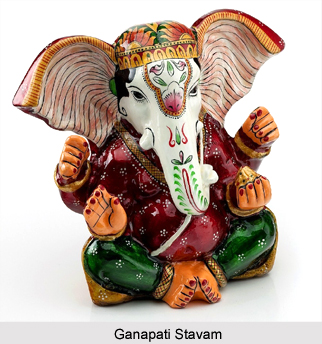 The Ganapati Stavam, also known as Ganapathi Sthavam, is one of the popular mantras of Lord Ganesha. It is chanted in praise of the deity by the worshippers of the elephant-headed god. Ganapati Stavam is a religious prayer composed in three verses. The powerful stotram is recited daily by the devotees. It helps in abolition of different obstacles and in achieving positive results and success in important ventures. The mantra is instilled with the divine blessings of Ganesha. The recitation of the stotram promotes general well-being brings prosperity in the life of the chanter and his family.
The Ganapati Stavam, also known as Ganapathi Sthavam, is one of the popular mantras of Lord Ganesha. It is chanted in praise of the deity by the worshippers of the elephant-headed god. Ganapati Stavam is a religious prayer composed in three verses. The powerful stotram is recited daily by the devotees. It helps in abolition of different obstacles and in achieving positive results and success in important ventures. The mantra is instilled with the divine blessings of Ganesha. The recitation of the stotram promotes general well-being brings prosperity in the life of the chanter and his family.
Ganapati Stavam is mentioned as follows-
Abheepsithartha Sidhyartham Poojitho Yassurair Api,
Sarva Vignaschidhe Thasmai Ganathipadaya Nama.
Gananam Adhipaschando Gajavakthrasthrilochana,
Preetho Bhavatu May Nithyam Varadatha Vinayaka.
Gajananam Ganapathim Gunanamalayam Param,
Thamdevam Girijasoonum Vandeham Amararchidham.
The recitation of the Ganapathi Sthavam offers salutations to the leader of the Ganas, divine army of Lord Shiva. The mantra mentions that Lord Ganesha is adored by all the gods. He removes of all obstacles and fulfills the desires of His worshippers. The deity is described as the Lord with the face of an elephant and three eyes. Ganesha is considered as a ferocious god. Thus the devotee chants the hymn to please the Lord and pray to the deity to bless him everyday and bestow him with boons. The devotee adores and worships Lord Ganesha who is the son of Goddess Parvati and the storehouse of all good things.
This article is a stub. You may enrich it by adding more information to it. You can send your write-up at content@indianetzone.com




















